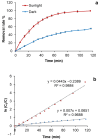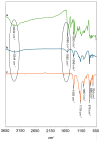Sustainable and Reusable Modified Membrane Based on Green Gold Nanoparticles for Efficient Methylene Blue Water Decontamination by a Photocatalytic Process
- PMID: 39404338
- PMCID: PMC11478303
- DOI: 10.3390/nano14191611
Sustainable and Reusable Modified Membrane Based on Green Gold Nanoparticles for Efficient Methylene Blue Water Decontamination by a Photocatalytic Process
Abstract
Methylene blue (MB) is a dye hazardous pollutant widely used in several industrial processes that represents a relevant source of water pollution. Thus, the research of new systems to avoid their environmental dispersion represents an important goal. In this work, an efficient and sustainable nanocomposite material based on green gold nanoparticles for MB water remediation was developed. Starting from the reducing and stabilizing properties of some compounds naturally present in Lambrusco winery waste (grape marc) extracts, green gold nanoparticles (GM-AuNPs) were synthesized and deposited on a supporting membrane to create an easy and stable system for water MB decontamination. GM-AuNPs, with a specific plasmonic band at 535 nm, and the modified membrane were first characterized by UV-vis spectroscopy, X-ray diffraction (XRD), and electron microscopy. Transmission electron microscopy analysis revealed the presence of two breeds of crystalline shapes, triangular platelets and round-shaped penta-twinned nanoparticles, respectively. The crystalline nature of GM-AuNPs was also confirmed from XRD analysis. The photocatalytic performance of the modified membrane was evaluated under natural sunlight radiation, obtaining a complete disappearance of MB (100%) in 116 min. The photocatalytic process was described from a pseudo-first-order kinetic with a rate constant (k) equal to 0.044 ± 0.010 min-1. The modified membrane demonstrated high stability since it was reused up to 20 cycles, without any treatment for 3 months, maintaining the same performance. The GM-AuNPs-based membrane was also tested with other water pollutants (methyl orange, 4-nitrophenol, and rhodamine B), revealing a high selectivity towards MB. Finally, the photocatalytic performance of GM-AuNPs-based membrane was also evaluated in real samples by using tap and pond water spiked with MB, obtaining a removal % of 99.6 ± 1.2% and 98.8 ± 1.9%, respectively.
Keywords: gold nanoparticles; grape marc; green synthesis; methylene blue; photocatalysis; sustainability; water remediation; winery waste.
Conflict of interest statement
The authors declare no conflicts of interest.
Figures














Similar articles
-
A facile green synthesis of gold nanoparticles using Canthium parviflorum extract sustainable and energy efficient photocatalytic degradation of organic pollutants for environmental remediation.Environ Res. 2024 Oct 1;258:119471. doi: 10.1016/j.envres.2024.119471. Epub 2024 Jun 22. Environ Res. 2024. PMID: 38914256
-
Biogenic synthesis of gold nanoparticles and their application in photocatalytic degradation of toxic dyes.J Photochem Photobiol B. 2018 Sep;186:51-58. doi: 10.1016/j.jphotobiol.2018.07.002. Epub 2018 Jul 7. J Photochem Photobiol B. 2018. PMID: 30015060
-
Green Synthesis of Iridium Nanoparticles from Winery Waste and Their Catalytic Effectiveness in Water Decontamination.Materials (Basel). 2023 Mar 2;16(5):2060. doi: 10.3390/ma16052060. Materials (Basel). 2023. PMID: 36903175 Free PMC article.
-
Coupling ZnO with CuO for efficient organic pollutant removal.Environ Sci Pollut Res Int. 2023 Jun;30(28):71984-72008. doi: 10.1007/s11356-022-24139-6. Epub 2022 Nov 22. Environ Sci Pollut Res Int. 2023. PMID: 36414902
-
Improved photocatalytic activity of gold decorated differently doped TiO₂ nanoparticles: A comparative study.Chemosphere. 2016 Feb;144:1655-64. doi: 10.1016/j.chemosphere.2015.10.060. Epub 2015 Oct 28. Chemosphere. 2016. PMID: 26519796
References
-
- Alprol A.E., Mansour A.T., Abdelwahab A.M., Ashour M. Advances in Green Synthesis of Metal Oxide Nanoparticles by Marine Algae for Wastewater Treatment by Adsorption and Photocatalysis Techniques. Catalysts. 2023;13:888. doi: 10.3390/catal13050888. - DOI
-
- Policarpo Tonelli F.M., Santos Silva C., Silva Delgado V.M., Policarpo Tonelli F.C. Algae-based green AgNPs, AuNPs, and FeNPs as potential nanoremediators. Green Process. Synth. 2023;12:20230008. doi: 10.1515/gps-2023-0008. - DOI
-
- Din M.I., Khalid R., Najee J., Hussain Z. Fundamentals and photocatalysis of methylene blue dye using various nanocatalytic assemblies—A critical review. J. Clean. Prod. 2021;298:126567. doi: 10.1016/j.jclepro.2021.126567. - DOI
Grants and funding
LinkOut - more resources
Full Text Sources
Miscellaneous

